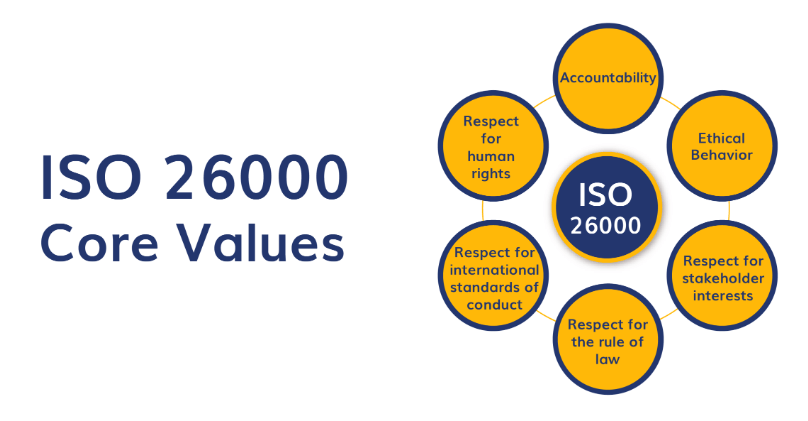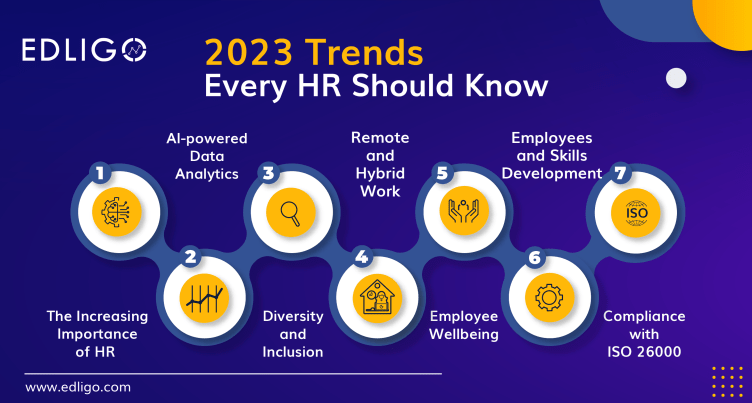HR leaders have been put to the test like never before in recent years. With the abrupt shift to remote work, mass resignations, economic volatility, and geopolitical upheaval, they were tested on all fronts. 2023 will be more than ever the year of human resources!
As an HR Leader, do you know how to turn 2023 HR trends into opportunities?
Employee well-being, AI-powered data analytics, diversity and inclusion, remote and hybrid work strategies, and employee and skill development have been top HR priorities for organizations as they work to adapt to massive disruption and change. Many of these trends will continue and evolve in the coming year as companies focus on communication, skill development, and relationship management.
The importance of human resources will increase dramatically in 2023. We see the major HR trends emerging in 2023:
- The Increasing Importance of HR
Traditionally, most CEOs concentrated their efforts on investors, strategies, boards of directors, and other similar matters. The responsibility that was under the control of the HR department has frequently been overlooked. Previously incidental concerns like talent, culture, employee expectations, and company-employee relations are now at the forefront. In the past, people were hired to execute the strategy, but today they are a fundamental cornerstone of the strategy.
HR can lead the organization on how to define work, professional relationships, and organizational and team design through agile experimentation.
So, how can CHROs leverage this opportunity to inspire and facilitate change within their organizations?
– Get involved:
HR managers should pay attention to the workforce’s explicit and sometimes implicit needs. This necessitates the executive team to actively listen to a variety of voices within the organization and constantly recalibrate priorities as individuals implement the talent strategy. And then be prepared to modify (again) as circumstances and needs evolve and change. Above all, be willing to experiment and be vulnerable.
– Make the connection:
HR must communicate their vision of company culture and invite diverse and opposing viewpoints into the conversation across race, gender, sexual orientation, and personal goals and ambitions. People want tangible proof that the organization they work for cares about their personal as well as professional needs from career development to mental health.
– Shape the culture:
Engagement and connection will ultimately shape a good culture, which will drive the company’s strategy and development. Nothing compares to culture. More than ever, corporate cultures must prioritize the future workforce and the future of work.
- AI-Powered Data Analytics and the Rise of Algorithmic HR
According to IDC, by 2024, 80% of the world’s largest 2,000 companies will use algorithmic managers for hiring, firing, and training employees.
In many organizations, human resources already play a strategic role. In the future, data analytics and reports will assist HR in becoming more informed and objective. AI-enabled analytics platforms, for example, can assist in identifying employee leave trends, employees at risk of leaving the company, and much more. The timely availability of data will undoubtedly aid HR and management in making strategic decisions and mitigating potential risks.
According to IDC, 40% of international companies’ HR functions have incorporated AI applications to help grow the candidate pool, enable faster hiring, and improve engagement and retention. HR professionals can make informed decisions about employees by collecting data on key metrics and using algorithmic managers powered by AI technology. Algorithmic managers can be an indispensable tool for processing large amounts of data, and they can be useful as a supplement to the complex decision-making that falls on HR professionals’ shoulders.
It is critical to avoid incorporating any existing biases in pre-existing HR data when programming and operating algorithmic managers. As a result, the new or rewritten algorithm can promote the principles of diversity, equity, and inclusion.
- Diversity and Inclusion in Modern Organizations
According to a Harvard Business Review study, diverse companies achieved a 19% higher revenue from innovation.
In the future, the emphasis will be on creating a diverse and inclusive workplace culture. Many organizations around the world have already adopted the concept of diversity and inclusion (D&I), and others are working on creating a diverse and inclusive workplace where no one is left behind. An inclusive workplace culture is one in which employees of all backgrounds and characteristics are welcomed and valued. Companies are now using HR technologies to create a diverse and inclusive workplace by eliminating bias, improving connectivity, and training employees. Overall, the goal is to provide a safe, secure, and inclusive workplace for all employees from various backgrounds and geographical locations.
According to Forbes, ethnically diverse companies are 35% more likely to outperform, while companies that are gender diverse are 15% more likely to outperform.
To create an inclusive culture, it is critical to incorporate transparency and fairness into all employee-related processes, such as goal setting, performance appraisals, feedback, compensation management, and others. It is also critical to keep your workforce motivated, engaged, and empowered.
- Remote and Hybrid Work Strategies
Throughout the pandemic, work has changed. According to McKinsey, the pandemic has accelerated digital transformation in organizations by three to four years. Companies have adapted accordingly. For example, according to LinkedIn data, remote jobs which account for approximately 20% of all jobs on LinkedIn, received more than 50% of all job applications. This demonstrates how resistance to some degree of flexible working will put organizations at a competitive disadvantage. Not all companies have recognized this workforce change, and they continue to cling to outdated strategies that once made sense. For instance, according to PWC, 95% of executives believe that employees must be present in the office to preserve company culture.
Employees prefer clear communication and up-to-date policies. By 2023, HR professionals will need to establish clear principles for how, where, and when work is performed. HR managers will facilitate internal discussions about this topic and encourage their organizations to make decisions, even if they are temporary, as organizations experiment with different workplace strategies. Professionals will also educate themselves and managers on how to overcome proximity bias, which is an unconscious tendency to favor in-office employees over remote workers. They will work on developing objective performance metrics, as well as promotion and salary increase criteria.
Clear working policies will influence office planning and utilization. This will result in better-designed workspaces, more flexible spaces to combat potential loneliness at home, and workspace allowances to upgrade home facilities.
- Employee Wellbeing
According to a Gartner survey of HR leaders, 47% consider employee experience to be their top priority for 2023.
Since 2020, employee expectations have shifted, and HR is witnessing the impact on the quality and quantity of employee attraction and retention across all industries. Every major event, from a candidate’s first impression to hiring and onboarding, their career path and development, and their decision to leave the company, is critical.
Employee wellness is now a top priority for companies. To promote a healthy work environment for their employees, an increasing number of organizations are implementing technology and wellness programs.
Employee happiness and health have a direct impact on team productivity and overall company performance. As a result, it is critical to improving workplace conditions to enhance employee well-being and performance.
As a current trend in HR technology, the emphasis on employee well-being is expected to grow stronger. Companies will implement strategies to assist employees in avoiding burnout and work stress, which will result in higher levels of satisfaction and employee retention. In some ways, in the coming years, we will see more personalized health and wellness systems powered by employee data.
- Employee and Skills Development
According to Gartner’s research, 58% of the workforce will need new skill sets to do their jobs successfully.
Employees are understandably looking for new opportunities for advancement elsewhere.
Improving employee skills is emerging as a major human resource trend. Upskilling and reskilling are critical not only for employee development but also for business growth. Organizations increase productivity and maximize investment by improving employee skill sets. Companies are encouraged to promote true innovation, reduce employment costs, and meet the needs of their customers. Employers have discovered that to meet future company requirements, they must clearly define the future skill set required for their employees. This will be one of the next global human resource trends to emerge, and it will be long-lasting.
As global organizations seek a competitive advantage through employee development, HR professionals are under increasing pressure to provide evidence of the success of their training initiatives. This will help people develop by providing the skills and behaviors needed to support the company’s strategy and growth goals, as well as increase revenue. It also assists in concentrating talent development investments in labor and operational support areas that have the greatest impact on profitability, as well as attracting and retaining top talent through enhanced personal and professional development opportunities.
- Compliance with ISO 26000
According to Holmes Report, 83% of professional investors say they are more likely to invest in companies known for their social responsibility.
For businesses and organizations committed to operating in a socially responsible way, there’s ISO 26000. It offers direction to those who understand that upholding social norms and the environment is essential to success. The implementation of ISO 26000 is increasingly seen to evaluate an organization’s commitment to sustainability and its overall performance, in addition to being the “right thing” to do.
The foundations of socially responsible behavior are outlined in ISO 26000’s core values. Companies will make sure to incorporate those values into their DNA and into each decision they make as part of their approach to responsibility.

Since there is much more public pressure on companies to act more socially responsibly and uphold social standards, social responsibility has grown to be a significant concern. Organizations all over the world must take the necessary steps to improve their social performance and change the world. They can start doing that by focusing on their people and providing them with equal opportunities, transparency at the workplace, and opportunities to grow together with the organization.
Human capital is an organization’s most asset and biggest competitive advantage. As a result, the most successful organizations are those that put HR at the core of their strategies and operations. The goal of ISO 26000 in human resource management is to assist HR departments in raising their levels of performance and, ultimately, the performance of their organizations. In the area of human resources, ISO 26000 has included labor practices as one of its core subjects, establishing requirements and actions that companies must take to demonstrate their socially responsible behavior.
EDLIGO Talent Analytics software assists improvement of an organization’s HR sustainability strategy and helps to achieve their ESG goals. Talent Analytics can support HR with a constant flow of data to predict and measure the impact of key strategic decisions and evaluate the organization’s future readiness.
For HR professionals to have a positive business impact in 2023 and beyond, we identified trends that every human resource department should be aware of. As the employee experience takes center stage in 2023, managers will focus on strengthening their bonds with their employees to support growth and development. The workplace has changed significantly in recent years and will continue to evolve. Companies will rely heavily on human resources, as well as the talent and experience of their teams, to meet the challenges ahead. To build a progressive workplace for the future, it is critical to implement the best HR practices and stay current on HR technology trends for 2023.
In an uncertain world, EDLIGO Talent Analytics assists organizations in establishing a clear, objective, and data-driven baseline for their employees. It offers an advanced analytics solution that helps corporations all over the world in driving targeted actions. Leaders can benefit from using the EDLIGO Talent Analytics solution to help shape business decisions, create internal mobility opportunities, personalize employees’ career paths, and enhance teamwork and interpersonal relationships.
If you would like to know more about how AI and Talent Analytics can help your organization to succeed, please contact the EDLIGO team.

